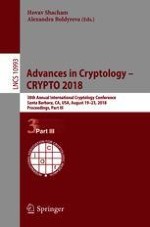2018 | OriginalPaper | Buchkapitel
An Optimal Distributed Discrete Log Protocol with Applications to Homomorphic Secret Sharing
verfasst von : Itai Dinur, Nathan Keller, Ohad Klein
Erschienen in: Advances in Cryptology – CRYPTO 2018
Aktivieren Sie unsere intelligente Suche, um passende Fachinhalte oder Patente zu finden.
Wählen Sie Textabschnitte aus um mit Künstlicher Intelligenz passenden Patente zu finden. powered by
Markieren Sie Textabschnitte, um KI-gestützt weitere passende Inhalte zu finden. powered by
